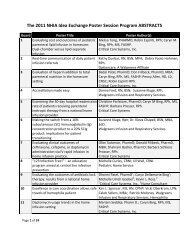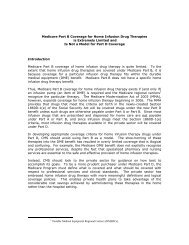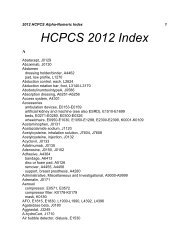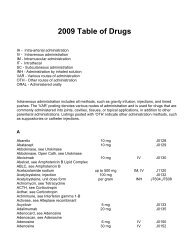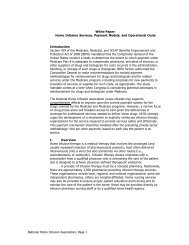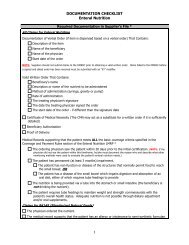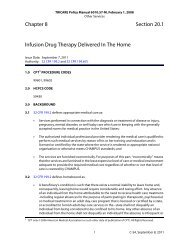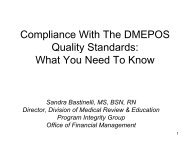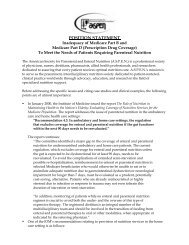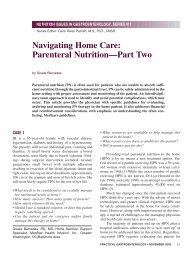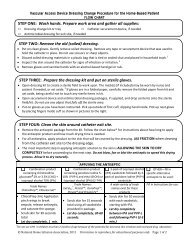Kaiser Family Foundation Survey on State Medicaid Managed Care ...
Kaiser Family Foundation Survey on State Medicaid Managed Care ...
Kaiser Family Foundation Survey on State Medicaid Managed Care ...
- No tags were found...
Create successful ePaper yourself
Turn your PDF publications into a flip-book with our unique Google optimized e-Paper software.
Special initiatives to improve quality and care coordinati<strong>on</strong>Key Secti<strong>on</strong> Findings:<strong>Medicaid</strong> programs have undertaken a range of strategies to improve care, including initiativesto reduce inappropriate use of ERs. Most states also have initiatives to reduce obesity, with<strong>Medicaid</strong> MCOs often playing a leading role.About half the states have <strong>Medicaid</strong> initiatives designed to reduce racial and ethnic disparitiesin care and outcomes, including participati<strong>on</strong> in broader state efforts.<strong>State</strong>s report a broad spectrum of other special managed care quality initiatives.Large numbers of states report initiatives to improve primary care and to better coordinatecare for <strong>Medicaid</strong> beneficiaries with more complex needs.<strong>Managed</strong> care has raised expectati<strong>on</strong>s regarding the quality and appropriateness of care delivered to<strong>Medicaid</strong> beneficiaries, and it has provided state <strong>Medicaid</strong> programs with structural mechanisms forexamining and potentially driving improvements in care. The survey asked states about their initiativesin three nati<strong>on</strong>al priority areas – reducing inappropriate emergency room use, improving obesity rates,and reducing racial and ethnic disparities. It also asked about their adopti<strong>on</strong> of strategies to promotemore coordinated care. <strong>State</strong> resp<strong>on</strong>ses indicate many kinds of activity <strong>on</strong> many fr<strong>on</strong>ts.Initiatives to improve qualityAll but a small number of states have initiatives toreduce the use of emergency rooms (ER) for n<strong>on</strong>emergentneeds. Initiatives to reduce inappropriate useof ERs were reported by 43 states. <strong>State</strong>s’ focus <strong>on</strong> thisissue was fueled by $50 milli<strong>on</strong> in CMS grants to states in2008 for ER diversi<strong>on</strong> projects. <strong>State</strong> approaches toreducing n<strong>on</strong>-emergency use of ERs vary, depending inpart <strong>on</strong> their managed care arrangements.<strong>State</strong>s with MCOs often include a focus <strong>on</strong> ER use in theirc<strong>on</strong>tracts. For example, some state c<strong>on</strong>tracts specify thatplans must m<strong>on</strong>itor ER use as part of their broaderm<strong>on</strong>itoring of over- and under-utilizati<strong>on</strong>. Some statesreported ER use as a factor in their P4P systems. <strong>State</strong>salso reported that plans identify high ER users and targetthem for case management or care coordinati<strong>on</strong>, or usedata <strong>on</strong> high ER users to profile providers and work withplan medical directors to improve utilizati<strong>on</strong> patterns.Through its statewide collaborative,“Implement <strong>Medicaid</strong> Programs for theReducti<strong>on</strong> of Avoidable Visits to theEmergency Department (IMPROVE),” Ohiocoordinated key stakeholders in five regi<strong>on</strong>sof high ED utilizati<strong>on</strong>. Regi<strong>on</strong>al participantsinclude hospitals, community providers,managed care plans, advocacy organizati<strong>on</strong>sand their respective associati<strong>on</strong>s, and<strong>Medicaid</strong> c<strong>on</strong>sumers. The IMPROVECollaborative adopted a rapid-cycle qualityimprovement approach, developed by theInstitute for Healthcare Improvement, that ispopulati<strong>on</strong>-based and patient-centered. Fiveregi<strong>on</strong>al groups, including executive/clinicalleaders of health care systems, partner withOhio <strong>Medicaid</strong> and managed care plans toidentify priority populati<strong>on</strong>s for the reducti<strong>on</strong>of avoidable ED visits.In states with PCCM programs, ER diversi<strong>on</strong> can involve a data system that notifies primary care doctorswhen their patients use the ER. Also, ER use is often included am<strong>on</strong>g the data used to profile PCPs. Somestates have established 24-hour nurse c<strong>on</strong>sultati<strong>on</strong> lines and/or other approaches to educatebeneficiaries <strong>on</strong> when it is appropriate to use the ER. <strong>State</strong>s also have used informati<strong>on</strong> technology toidentify high users of ERs and established case management programs for those with ER use exceeding aspecified threshold, such as five or more visits in a 90-day period.39



